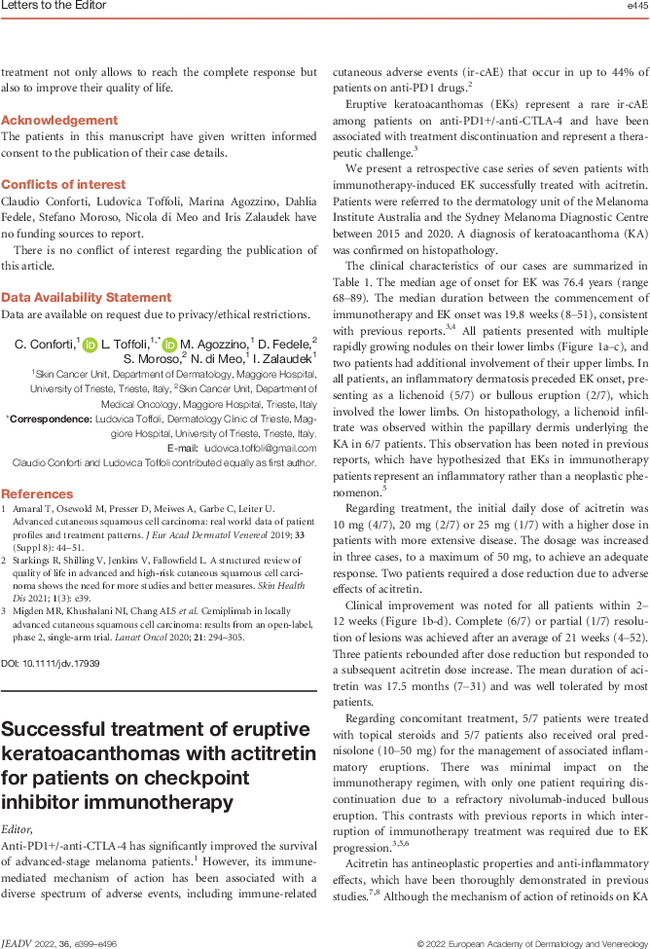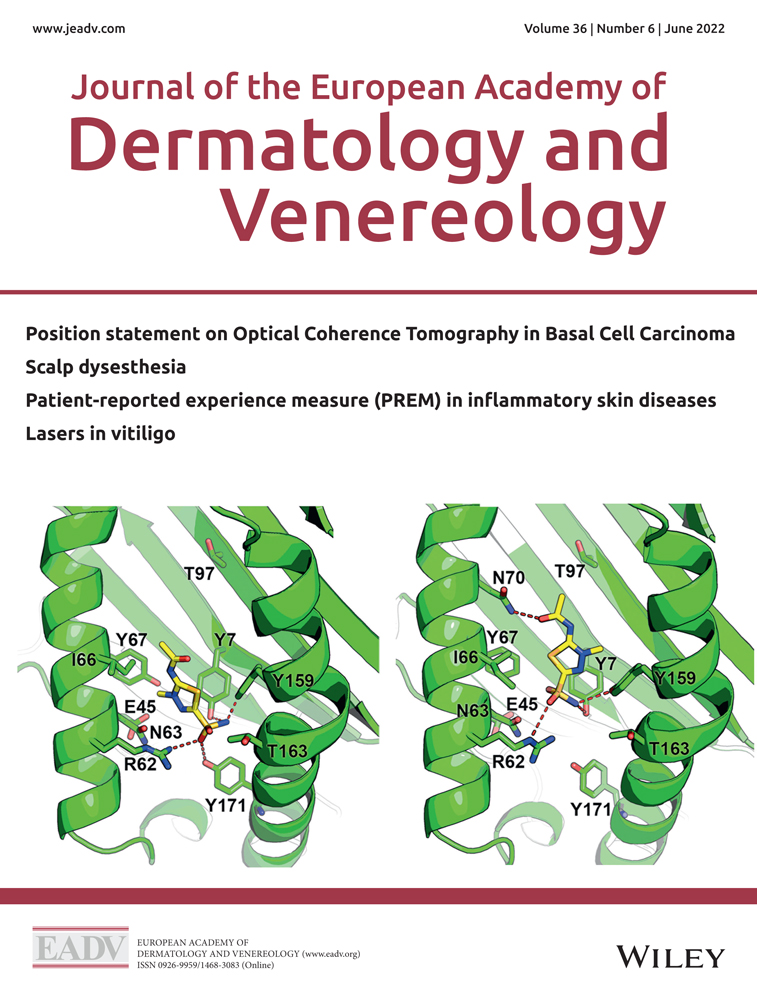Successful treatment of eruptive keratoacanthomas with actitretin for patients on checkpoint inhibitor immunotherapy
Corresponding Author
R.J. Schwartz
Melanoma Institute Australia, The University of Sydney, Sydney, NSW, Australia
Department of Dermatology, Faculty of Medicine, University of Chile, Santiago, Chile
*Correspondence: R. Schwartz. E-mail: [email protected]
Search for more papers by this authorG. Ho
Melanoma Institute Australia, The University of Sydney, Sydney, NSW, Australia
Faculty of Medicine and Health, The University of Sydney, Sydney, NSW, Australia
Search for more papers by this authorA. Smith
Melanoma Institute Australia, The University of Sydney, Sydney, NSW, Australia
Faculty of Medicine and Health, The University of Sydney, Sydney, NSW, Australia
Search for more papers by this authorH. Collgros
Faculty of Medicine and Health, The University of Sydney, Sydney, NSW, Australia
Sydney Melanoma Diagnostic Centre, Royal Prince Alfred Hospital, Sydney, NSW, Australia
Search for more papers by this authorA. Regio Pereira
Faculty of Medicine and Health, The University of Sydney, Sydney, NSW, Australia
Sydney Melanoma Diagnostic Centre, Royal Prince Alfred Hospital, Sydney, NSW, Australia
Federal University of Sao Paulo, Sao Paulo, Brazil
Search for more papers by this authorB. Gouveia
Melanoma Institute Australia, The University of Sydney, Sydney, NSW, Australia
Search for more papers by this authorG.V. Long
Melanoma Institute Australia, The University of Sydney, Sydney, NSW, Australia
Faculty of Medicine and Health, The University of Sydney, Sydney, NSW, Australia
Royal North Shore and Mater Hospitals, Sydney, NSW, Australia
Charles Perkins Centre, The University of Sydney, Sydney, NSW, Australia
Search for more papers by this authorA.M. Menzies
Melanoma Institute Australia, The University of Sydney, Sydney, NSW, Australia
Faculty of Medicine and Health, The University of Sydney, Sydney, NSW, Australia
Royal North Shore and Mater Hospitals, Sydney, NSW, Australia
Search for more papers by this authorA.J. Potter
Melanoma Institute Australia, The University of Sydney, Sydney, NSW, Australia
Faculty of Medicine and Health, The University of Sydney, Sydney, NSW, Australia
Faculty of Medicine and Health, University of New South Wales, Sydney, NSW, Australia
Tissue and Pathology Diagnostic Oncology, Royal Prince Alfred Hospital and NSW Health Pathology, Sydney, NSW, Australia
Search for more papers by this authorE. Paver
Melanoma Institute Australia, The University of Sydney, Sydney, NSW, Australia
Faculty of Medicine and Health, The University of Sydney, Sydney, NSW, Australia
Tissue and Pathology Diagnostic Oncology, Royal Prince Alfred Hospital and NSW Health Pathology, Sydney, NSW, Australia
Search for more papers by this authorP. Star
Melanoma Institute Australia, The University of Sydney, Sydney, NSW, Australia
Search for more papers by this authorR.A. Scolyer
Melanoma Institute Australia, The University of Sydney, Sydney, NSW, Australia
Faculty of Medicine and Health, The University of Sydney, Sydney, NSW, Australia
Charles Perkins Centre, The University of Sydney, Sydney, NSW, Australia
Tissue and Pathology Diagnostic Oncology, Royal Prince Alfred Hospital and NSW Health Pathology, Sydney, NSW, Australia
Search for more papers by this authorL.K. Martin
Melanoma Institute Australia, The University of Sydney, Sydney, NSW, Australia
Faculty of Medicine and Health, The University of Sydney, Sydney, NSW, Australia
Faculty of Medicine and Health, University of New South Wales, Sydney, NSW, Australia
Search for more papers by this authorCorresponding Author
R.J. Schwartz
Melanoma Institute Australia, The University of Sydney, Sydney, NSW, Australia
Department of Dermatology, Faculty of Medicine, University of Chile, Santiago, Chile
*Correspondence: R. Schwartz. E-mail: [email protected]
Search for more papers by this authorG. Ho
Melanoma Institute Australia, The University of Sydney, Sydney, NSW, Australia
Faculty of Medicine and Health, The University of Sydney, Sydney, NSW, Australia
Search for more papers by this authorA. Smith
Melanoma Institute Australia, The University of Sydney, Sydney, NSW, Australia
Faculty of Medicine and Health, The University of Sydney, Sydney, NSW, Australia
Search for more papers by this authorH. Collgros
Faculty of Medicine and Health, The University of Sydney, Sydney, NSW, Australia
Sydney Melanoma Diagnostic Centre, Royal Prince Alfred Hospital, Sydney, NSW, Australia
Search for more papers by this authorA. Regio Pereira
Faculty of Medicine and Health, The University of Sydney, Sydney, NSW, Australia
Sydney Melanoma Diagnostic Centre, Royal Prince Alfred Hospital, Sydney, NSW, Australia
Federal University of Sao Paulo, Sao Paulo, Brazil
Search for more papers by this authorB. Gouveia
Melanoma Institute Australia, The University of Sydney, Sydney, NSW, Australia
Search for more papers by this authorG.V. Long
Melanoma Institute Australia, The University of Sydney, Sydney, NSW, Australia
Faculty of Medicine and Health, The University of Sydney, Sydney, NSW, Australia
Royal North Shore and Mater Hospitals, Sydney, NSW, Australia
Charles Perkins Centre, The University of Sydney, Sydney, NSW, Australia
Search for more papers by this authorA.M. Menzies
Melanoma Institute Australia, The University of Sydney, Sydney, NSW, Australia
Faculty of Medicine and Health, The University of Sydney, Sydney, NSW, Australia
Royal North Shore and Mater Hospitals, Sydney, NSW, Australia
Search for more papers by this authorA.J. Potter
Melanoma Institute Australia, The University of Sydney, Sydney, NSW, Australia
Faculty of Medicine and Health, The University of Sydney, Sydney, NSW, Australia
Faculty of Medicine and Health, University of New South Wales, Sydney, NSW, Australia
Tissue and Pathology Diagnostic Oncology, Royal Prince Alfred Hospital and NSW Health Pathology, Sydney, NSW, Australia
Search for more papers by this authorE. Paver
Melanoma Institute Australia, The University of Sydney, Sydney, NSW, Australia
Faculty of Medicine and Health, The University of Sydney, Sydney, NSW, Australia
Tissue and Pathology Diagnostic Oncology, Royal Prince Alfred Hospital and NSW Health Pathology, Sydney, NSW, Australia
Search for more papers by this authorP. Star
Melanoma Institute Australia, The University of Sydney, Sydney, NSW, Australia
Search for more papers by this authorR.A. Scolyer
Melanoma Institute Australia, The University of Sydney, Sydney, NSW, Australia
Faculty of Medicine and Health, The University of Sydney, Sydney, NSW, Australia
Charles Perkins Centre, The University of Sydney, Sydney, NSW, Australia
Tissue and Pathology Diagnostic Oncology, Royal Prince Alfred Hospital and NSW Health Pathology, Sydney, NSW, Australia
Search for more papers by this authorL.K. Martin
Melanoma Institute Australia, The University of Sydney, Sydney, NSW, Australia
Faculty of Medicine and Health, The University of Sydney, Sydney, NSW, Australia
Faculty of Medicine and Health, University of New South Wales, Sydney, NSW, Australia
Search for more papers by this author
Conflict of interest
RAS has received fees for professional services from F. Hoffmann-La Roche Ltd, Evaxion, Provectus Biopharmaceuticals Australia, Qbiotics, Novartis, Merck Sharp & Dohme, NeraCare, AMGEN Inc., Bristol-Myers Squibb, Myriad Genetics, GlaxoSmithKline. LKM has received fees for professional services from Bristol-Myers Squibb. GVL is consultant advisor for Aduro Biotech Inc, Amgen Inc, Array BioPharma Inc, Boehringer Ingelheim International GmbH, Bristol-Myers Squibb, Evaxion Biotech A/S, Hexel AG, Highlight Therapeutics S.L., Merck Sharpe & Dohme, Novartis Pharma AG, OncoSec, Pierre Fabre, QBiotics Group Limited, Regeneron Pharmaceuticals Inc, SkylineDX B.V., Specialised Therapeutics Australia Pty Ltd. AMM has served on advisory boards for BMS, MSD, Novartis, Roche, Pierre-Fabre and QBiotics.
Open Research
Data availability statement
The data that support the findings of this study are available from the corresponding author upon reasonable request.
References
- 1Robert C, Ribas A, Schachter J et al. Pembrolizumab versus ipilimumab in advanced melanoma (KEYNOTE-006): post-hoc 5-year results from an open-label, multicentre, randomised, controlled, phase 3 study. Lancet Oncol 2019; 20: 1239–1251.
- 2Belum VR, Benhuri B, Postow MA et al. Characterisation and management of dermatologic adverse events to agents targeting the PD-1 receptor. Eur J Cancer 2016; 60: 12–25.
- 3Feldstein SI, Patel F, Larsen L, Kim E, Hwang S, Fung MA. Eruptive keratoacanthomas arising in the setting of lichenoid toxicity after programmed cell death 1 inhibition with nivolumab. J Eur Acad Dermatology Venereol 2018; 32: e58–e59.
- 4Freites-Martinez A, Kwong BY, Rieger KE, Coit DG, Colevas AD, Lacouture ME. Eruptive keratoacanthomas associated with pembrolizumab therapy. JAMA Dermatol 2017; 153: 694–697.
- 5Crow LD, Perkins I, Twigg AR et al. Treatment of PD-1/PD-L1 inhibitor-induced dermatitis resolves concomitant eruptive keratoacanthomas. JAMA Dermatol 2020; 156: 598–600.
- 6Bandino JP, Perry DM, Clarke CE, Marchell RM, Elston DM. Two cases of anti-programmed cell death 1-associated bullous pemphigoid-like disease and eruptive keratoacanthomas featuring combined histopathology. J Eur Acad Dermatology Venereol 2017; 31: e378–e380.
- 7Herold M, Good AJ, Nielson CB, Longo MI. Use of topical and systemic retinoids in solid organ transplant recipients: update and review of the current literature. Dermatologic Surg 2019; 45: 1442–1449.
- 8Guenther LC, Kunynetz R, Lynde CW et al. Acitretin use in dermatology. J Cutan Med Surg 2017; 21: 2S–12S.
- 9Street ML, White JW, Gibson LE. Multiple keratoacanthomas treated with oral retinoids. J Am Acad Dermatol 1990; 23: 862–866.
- 10Griffiths RW. Keratoacanthoma observed. Br J Plast Surg 2004; 57: 485–501.




